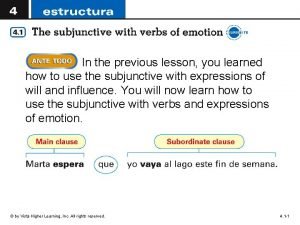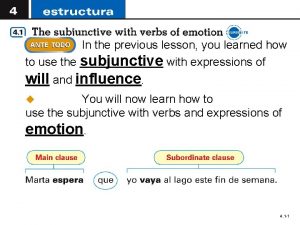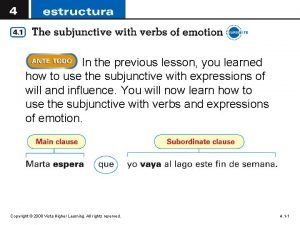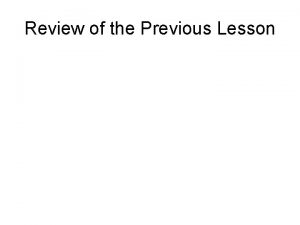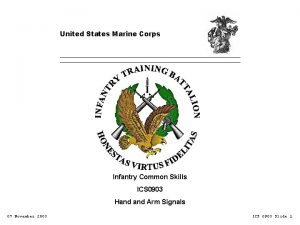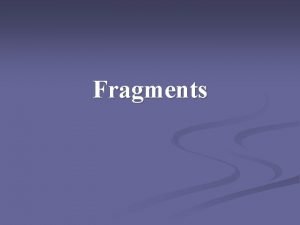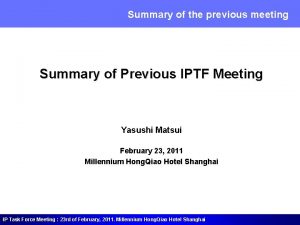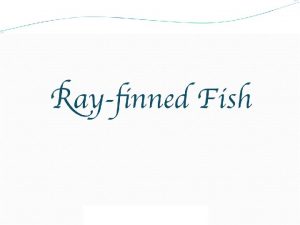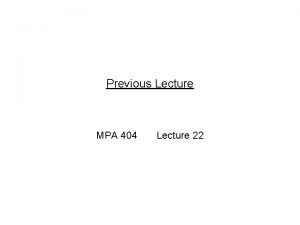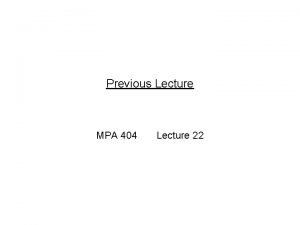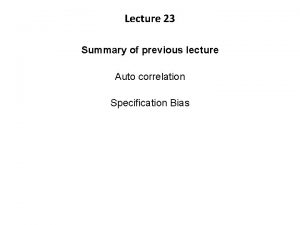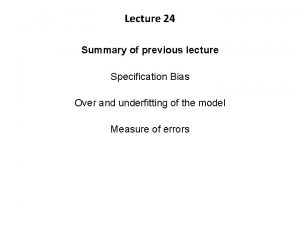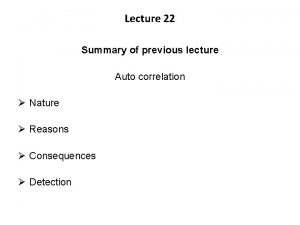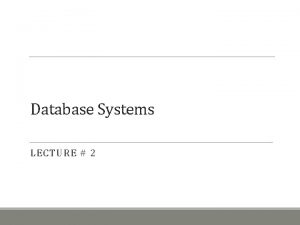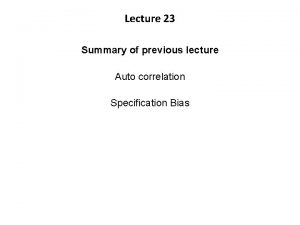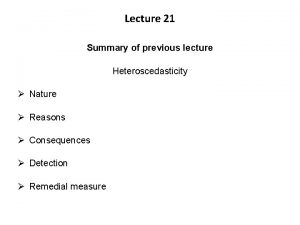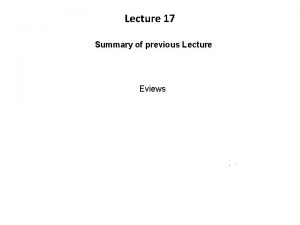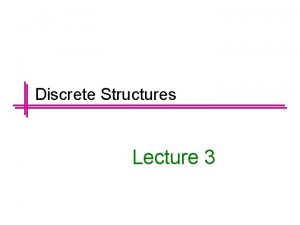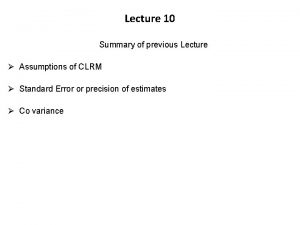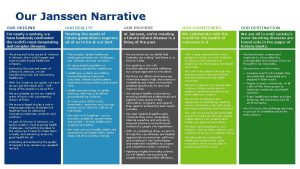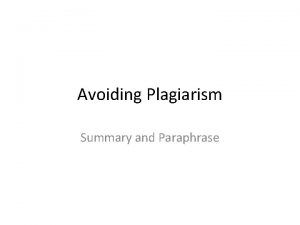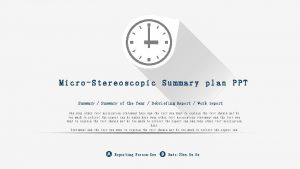Summary of Previous Lecture In our previous lecture
































- Slides: 32

Summary of Previous Lecture In our previous lecture about Accounts Receivable and Inventory Management we studied the following topics; • Sources of information on credit applicants and how you might use the information to analyze a credit applicant. • Various types of inventories and the advantages and disadvantages of increasing/decreasing inventories. • Effective inventory management and control, including classification, economic order quantity (EOQ), order point, safety stock, and just-in-time (JIT).

Chapter 11 (I) Short-Term Financing

Learning Outcomes After studying Chapter 11, you should be able to: • Understand the sources and types of spontaneous financing. • Calculate the annual cost of trade credit when trade discounts are forgone. • Explain what is meant by "stretching payables" and understand its potential drawbacks. • Describe various types of negotiated (or external) shortterm borrowing. • Calculate the effective annual interest rate on short-term borrowing with or without a compensating balance requirement and/or a commitment fee. • Understand what is meant by factoring accounts receivable.

Short-Term Financing • Spontaneous Financing • Negotiated Financing • Factoring Accounts Receivable • Composition of Short-Term Financing

Spontaneous Financing Short term financing can be categorized according to the source whether spontaneous or not. Types of spontaneous financing – Accounts Payable (Trade Credit from Suppliers) – Accrued Expenses Because they arise naturally from firms operations and the magnitude varies according to the operations of the business.

Spontaneous Financing Accounts Payable (Trade Credit) - credit granted from one business to another. Supplier are more liberal in the extension of credit than are financial institution. Companies rely heavily on trade credits. Examples or trade credit; 1. Open Accounts: the seller ships goods to the buyer with an invoice specifying goods shipped, total amount due, and terms of the sale. It is called open as no debt instrument is signed as an evidence to the credit. It appears in buyer’s books as accounts payable 2. Notes Payable: the buyer signs a note that evidences a debt to the seller and payment at a specified date.

Spontaneous Financing 3. Trade Acceptances: the seller draws a draft on the buyer that orders the buyer to pay the draft at some future date. The seller will release the goods only after the buyer accepts the time draft. And then the draft become a trade acceptance and is also marketable. • Draft -- A signed, written order by which the first party the seller (drawer) instructs a second party the buyer (drawee) to pay a specified amount of money to a third party (payee). The drawer and payee are often one and the same.

Terms of the Sale Because of limited use of promissory notes and trade acceptances, open account trade credit is practiced. The terms specified in the invoice are classified according to net period within which the payment is expected and the cash discount offered.

Terms of the Sale 1. COD and CBD - No Trade Credit: The buyer pays cash on delivery or cash before delivery. This increases the seller’s risk under COD in case the buyer refuses the shipment. The risk can be eliminated completely using CBD. 2. Net Period - No Cash Discount when credit is extended, the seller specifies the period of time allowed for payment. “Net 30” implies full payment in 30 days from the invoice date. If the seller bills on monthly basis it might require “net 15, EOM” meaning the goods shipped before end of month must be paid by the 15 of the following month.

Terms of the Sale 3. Net Period - Cash Discount - when credit is extended, the seller specifies the period of time allowed for payment and offers a cash discount if paid in the early part of the period. “ 2/10, net 30” implies full payment within 30 days from the invoice date less a 2% discount if paid within 10 days. A cash discount is different from trade discount and quantity discount. 4. Seasonal Dating - credit terms that encourage the buyer of seasonal products to take delivery before the peak sales period and to defer payment until after the peak sales period.

Trade Credit as a Means of Financing What happens to accounts payable if a firm purchases $5, 000/day at “net 30”? $5, 000 x 30 days = $150, 000 account balance What happens to accounts payable if a firm purchases $6, 000/day at “net 30”? $6, 000 x 30 days = $180, 000 account balance A $30, 000 increase from operations! Trade credit becomes a spontaneous source of financing that varies with the production cycle.

Payment on Final Due Date • If there is no cash discount, there is no cost for the use of the credit during the net period. • If the firm takes a discount, there is no cost for the use of trade credit during the discount period. • If a cash discount is offered but not taken, there is a definite opportunity cost.

Cost to Forgo a Discount What is the approximate annual cost to forgo the cash discount of “ 2/10, net 30” after the first ten days? Approximate annual interest cost = Cost on annual percentage basis for not taking a cash discount $2 = $98 x (X%) x 20 days/365 days % discount 365 days X (100% - % discount) (payment date - discount period)

Cost to Forgo a Discount What is the approximate annual cost to forgo the cash discount of “ 2/10, net 60, ” and pay at the end of the credit period? Approximate annual interest cost = 2% (100% - 2%) X 365 days (30 days - 10 days) = (2/98) x (365/50) = 14. 9%

Cost to Forgo a Discount The approximate interest cost over a variety of payment decisions for “ 2/10, net ____” Payment Date* 11 20 30 60 90 * days from invoice date Annual rate of interest 744. 9% 74. 5 37. 2 14. 9 9. 3

S-t-r-e-t-c-h-i-n-g Account Payables Postponing payment beyond the end of the net (credit) period is known as “stretching accounts payable” or “leaning on the trade. ” It generates additional short term financing for the firm by an additional build up in liability. But it comes at a cost; Possible costs of “stretching accounts payable” • Cost of the cash discount (if any) forgone • Late payment penalties or interest • Deterioration in credit rating along with firm’s ability to obtain future credit.

S-t-r-e-t-c-h-i-n-g Account Payables Suppliers want to expand their business and may be willing with stretching payables, particularly if the risk of bad debt losses in negligible. Also for a seasonal funds requirement the supplier may allow the stretching during periods of peak requirements. The supplier should be fully informed in case of stretching payables.

Advantages of Trade Credit Compare costs of forgoing a possible cash discount against the advantages of trade credit. The possible advantage may include; • Convenience and availability of trade credit, i. e. ready availability without further negotiation • Continuous form of credit that can increase or decrease with the volume of transaction. Greater flexibility as a means of financing as the supplier views the occasional delays as far less critical than a banker or other financial institution. •

Who Bears the Cost of Funds for Trade Credit? • Suppliers - when trade costs cannot be passed on to buyers because of price competition and slow demand. The supplier will absorb the cost of trade credit. • Buyers - when costs can be fully passed on through higher prices to the buyer by the seller. In this case the buyer should look for a better substitute. • Both - when costs can partially be passed on to buyers by sellers.

Accrued Expenses - Amounts owed but not yet paid for wages, taxes, interest, and dividends. The accrued expenses account is a short-term liability and represent a spontaneous source of financing. Accrued expenses are costless financing. § Wages - Benefits accrue via no direct cash costs, but costs can develop by reduced employee morale and efficiency in case of stretching the payments. § Taxes - Benefits accrue until the due date, but costs of penalties and interest beyond the due date reduce the benefits.

Negotiated Financing Types of negotiated financing: Money Market Credit – Commercial Paper – Bankers’ Acceptances – Unsecured Loans* Ø Line of Credit Ø Revolving Credit Agreement Ø Transaction Loan * Secured versions of these three loans also exist.

Stand-alone Commercial Paper - Short-term, unsecured promissory notes, generally issued by large and most credit worthy companies. Rating agencies rate the papers. Commercial paper market is composed of the 1. Dealer market – Industrial firms, utilities, and medium size finance companies sell through dealers. The dealer organization is composed of half dozen major dealers who purchase commercial papers from dealers and sell to investors. 2. Direct-placement markets – Large finance companies bypass dealer firms and sell their paper directly to investors. Maturity and size of the notes is tailored to the need of investor.

Stand-alone Commercial Paper – Advantage: Cheaper than a short-term business loan from a commercial bank. – Dealers require a line of credit to ensure that the commercial paper is paid off and this provides an added assurance that Commercial paper will be paid off.

Bank-Supported Commercial Paper A bank provides a letter of credit, for a fee, guaranteeing the investor that the company’s obligation will be paid. – Letter of credit (L/C) - A promise from a third party (usually a bank) for payment in the event that certain conditions are met. It is frequently used to guarantee payment of an obligation. Usually firms trading with each other across the borders will seek such assurances. – Best for lesser-known firms to access lower cost funds.

Bankers’ Acceptances - Short-term promissory trade notes for which a bank (by having “accepted” them) promises to pay the holder the face amount at maturity. – Used to facilitate foreign trade or the shipment of certain marketable goods. – Liquid market provides rates similar to commercial paper rates.

Bankers’ Acceptances Example; When an American company wishes to import $100, 000 worth of electronic components from a company in Japan, the two companies agree that a 90 -day time draft will be used in settlement of the trade. The American company arranges a letter of credit with its bank whereby the bank agrees to honor drafts drawn on the company as presented through a Japanese bank. The Japanese company ships the goods and at the same time draws a draft ordering the American company to pay in 90 days. It then takes the draft to its Japanese bank. By prearrangement, the draft is sent to the American bank and is accepted by that bank. At that time it becomes a bankers’ acceptance. The bank accepts responsibility for payment, thereby substituting its creditworthiness for that of the drawee, the American company.

Short-Term Business Loans Business loans are of two types; Unsecured Loans -- A form of debt for money borrowed that is not backed by the pledge of specific assets. Only credit worthy borrower deserves unsecured loans and can borrow at lower cost from commercial banks than the finance companies. Secured Loans -- A form of debt for money borrowed in which specific assets have been pledged to guarantee payment.

Unsecured Loans Line of Credit - An informal arrangement between a bank and its customer specifying the maximum amount of credit the bank will permit the firm to owe at any one time. • One-year limit that is reviewed prior to renewal to determine if conditions necessitate a change. • Credit line is based on the bank’s assessment of the creditworthiness and credit needs of the firm. • “Cleanup” provision requires the firm to owe the bank nothing for a period of time.

Sample Letter Extending a Line of Credit

Unsecured Loans Revolving Credit Agreement - A formal, legal commitment to extend credit up to some maximum amount over a stated period of time. • Firm receives revolving credit by paying a commitment fee on any unused portion of the maximum amount of credit. Commitment fee - A fee charged by the lender for agreeing to hold credit available. • Agreements frequently extend beyond 1 year.

Unsecured Loans Transaction Loan -- A loan agreement that meets the short-term funds needs of the firm for a single, specific purpose. • Each request is handled as a separate transaction by the bank, and project loan determination is based on the cash-flow ability of the borrower. • The loan is paid off at the completion of the project by the firm from resulting cash flows.

Summary In today’s lecture we covered the following topics. • sources and types of spontaneous financing. • Calculate the annual cost of trade credit when trade discounts are forgone. • Stretching payables and its potential drawbacks. • Describe various types of negotiated (or external) short-term borrowing.
 Previous lesson means
Previous lesson means In the previous lesson you learned how to express
In the previous lesson you learned how to express In the previous lesson you have learned that
In the previous lesson you have learned that 01:640:244 lecture notes - lecture 15: plat, idah, farad
01:640:244 lecture notes - lecture 15: plat, idah, farad Thinking language and intelligence
Thinking language and intelligence Our census our future
Our census our future Christ, be our light
Christ, be our light Our life is what our thoughts make it
Our life is what our thoughts make it We bow our hearts we bend our knees
We bow our hearts we bend our knees Our census our future
Our census our future Our life is what our thoughts make it
Our life is what our thoughts make it We quail money makes us quail why
We quail money makes us quail why Our awareness of ourselves and our environment
Our awareness of ourselves and our environment Awareness of ourselves and our environment is
Awareness of ourselves and our environment is God our father christ our brother
God our father christ our brother Our future is in our hands quotes
Our future is in our hands quotes Awareness of ourselves and our environment is
Awareness of ourselves and our environment is Awareness of ourselves and our environment
Awareness of ourselves and our environment Randy pausch last lecture summary
Randy pausch last lecture summary Lecture to a missionary summary
Lecture to a missionary summary Our iceberg is melting summary
Our iceberg is melting summary The men we carry in our minds pdf
The men we carry in our minds pdf Our failing schools enough is enough summary
Our failing schools enough is enough summary Our failing schools enough is enough summary
Our failing schools enough is enough summary Previous owner of oregon country
Previous owner of oregon country In the previous lesson i learned that accounting
In the previous lesson i learned that accounting Uil science
Uil science In the previous lesson i learned that
In the previous lesson i learned that Leaders join me hand and arm signal
Leaders join me hand and arm signal Based on the following examples (previous fragments)
Based on the following examples (previous fragments) Based on the following examples (previous fragments)
Based on the following examples (previous fragments) Charles maurice de talleyrand-périgord previous offices
Charles maurice de talleyrand-périgord previous offices Hud 2530
Hud 2530
